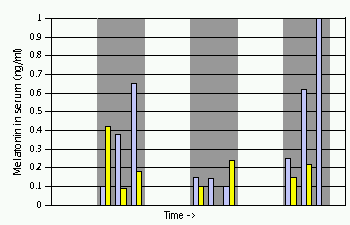The mechanism behind this pattern of secretion during the dark cycle is that activity of the rate-limiting enzyme in melatonin synthesis - serotonin N-acetyltransferase (NAT) - is low during daylight and peaks during the dark phase. In some species, circadian changes in NAT activity are tightly correlated with transcription of the NAT messenger RNA, while in other species, post-transcriptional regulation of NAT activity is responsible. Activity of the other enzyme involved in synthesis of melatonin from serotonin - the methyltransferase - does not show regulation by pattern of light exposure.
Two melatonin receptors have been identified from mammals (designated Mel1A and Mel1B) that are differentially expressed in different tissues and probably participate in implementing differing biologic effects. These are G protein-coupled cell surface receptors. The highest density of receptors has been found in the suprachiasmatic nucleus of the hypothalamus, the anterior pituitary (predominantly pars tuberalis) and the retina. Receptors are also found in several other areas of the brain.
Biological Effects of Melatonin
Melatonin has important effects in integrating photoperiod and affecting circadian rhythms. Consequently, it has been reported to have significant effects on reproduction, sleep-wake cycles and other phenomena showing circadian rhythm.
Effects on Reproductive Function

Seasonal changes in daylength have profound effects on reproduction in many species, and melatonin is a key player in controlling such events. In temperate climates, animals like hamsters, horses and sheep have distinct breeding season. During the non-breeding season, the gonads become inactive (e.g males fail to produce sperm in any number), but as the breeding season approaches, the gonads must be rejuvenated. Photoperiod - the length of day vs night - is the most important cue allowing animals to determine which season it is. As you've probably deduced by now, the pineal gland is able to measure daylength and adjust secretion of melatonin accordingly. A hamster without a pineal gland or with a lesion that prevents the pineal from receiving photoinformation is not able to prepare for the breeding season.
The effect of melatonin on reproductive systems can be summarized by saying that it is anti-gonadotropic. In other words, melatonin inhibits the secretion of the gonadotropic hormones luteinizing hormone and follicle stimulating hormone from the anterior pituitary. Much of this inhibitory effect seems due to inhibition of gonadotropin-releasing hormone from the hypothalamus, which is necessary for secretion of the anterior pituitary hormones.
One practical application of melatonin's role in controlling seasonal reproduction is found in its use to artificially manipulate cycles in seasonal breeders. For example, sheep that normally breed only once per year can be induced to have two breeding seasons by treatment with melatonin.
Effects on Sleep and Activity
Melatonin is probably not a major regulator of normal sleep patterns, but undoubtedly has some effect. One topic that has garnered a large amount of interest is using melatonin alone, or in combination with phototherapy, to treat sleep disorders. There is some indication that melatonin levels are lower in elderly insomniacs relative to age matched non-insomniacs, and melatonin therapy in such cases appears modestly beneficial in correcting the problem.

Another sleep disorder is seen in shift workers, who often find it difficult to adjust to working at night and sleeping during the day. The utility of melatonin therapy to aleviate this problem is equivocal and appears not to be as effective as phototherapy. Still another condition involving disruption of circadian rhythms is jet lag. In this case, it has repeatedly been demonstrated that taking melatonin close to the target bedtime of the destination can alleviate symptoms; it has the greatest beneficial effect when jet lag is predicted to be worst (e.g. crossing many time zones).
In various species including humans, administration of melatonin has been shown to decrease motor activity, induce fatigue and lower body temperature, particularly at high doses. The effect on body temperature may play a significant role in melatonin's ability to entrain sleep-wake cycles, as in patients with jet lag.
Other Effects of Melatonin
One of the first experiments conducted to elucidate the function of the pineal, extracts of pineal glands from cattle were added to water containing tadpoles. Interestingly, the tadpoles responded by becoming very light in color or almost transparent due to alterations in melanin pigment distribution. Although such cutaneous effects of melatonin are seen in a variety of "lower species", the hormone does not have such effects in mammals or birds.
|


